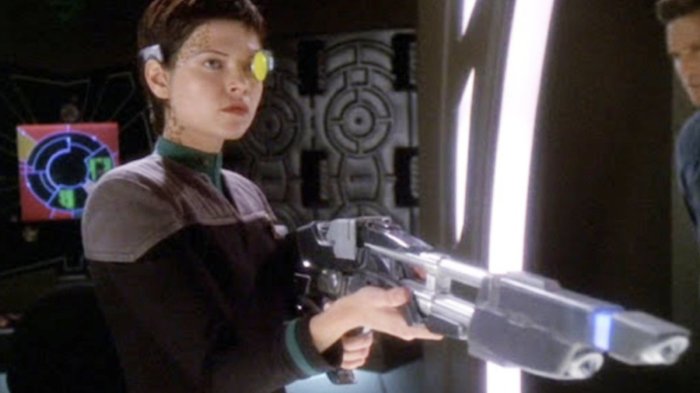Weapons in Star Trek play a pivotal role in shaping the narrative, showcasing advanced technology and ethical dilemmas that define the universe. From phasers to photon torpedoes, these weapons have become iconic symbols of the franchise, leaving an indelible mark on popular culture.
Throughout the series, weapons have served as tools of defense, aggression, and exploration, reflecting the complex nature of the Star Trek universe. Their usage raises profound questions about the ethics of warfare, the impact of technology on society, and the enduring human fascination with weaponry.
Weapon Types
In the vast expanse of the Star Trek universe, weapons have played a pivotal role in shaping the destiny of civilizations and individuals alike. From the humble phaser to the devastating photon torpedo, the Federation and its allies have wielded a diverse arsenal to defend themselves and uphold their ideals.
Phaser: A versatile energy weapon, the phaser is the standard sidearm of Starfleet personnel. It emits a concentrated beam of energy that can be set to stun or kill.
Photon Torpedo: A powerful explosive device, the photon torpedo is capable of inflicting severe damage to starships and other targets. It utilizes a matter-antimatter reaction to generate an explosive yield.
Quantum Torpedo: An advanced weapon developed by the Federation, the quantum torpedo combines the power of a photon torpedo with the ability to create a subspace anomaly, increasing its destructive potential.
Weapon Usage
The use of weapons in Star Trek is a complex and multifaceted issue. While the Federation strives for peaceful coexistence, it recognizes the need for self-defense and the protection of its citizens.
Defensive Use: Weapons are primarily employed for defensive purposes, to repel attacks and protect against threats. Starfleet ships are equipped with shields and defensive systems to minimize damage.
Offensive Use: In extreme situations, weapons may be used offensively to neutralize hostile forces or prevent further aggression. However, the Federation strictly adheres to ethical guidelines and avoids unnecessary violence.
Non-Lethal Options: Star Trek weapons often feature non-lethal settings, such as the stun function on phasers. These options allow for incapacitation without causing permanent harm.
Weapon Development
The history of weapon development in Star Trek is marked by significant milestones and advancements.
Early Weapons: In the early days of the Federation, weapons were relatively primitive. Phasers and photon torpedoes were less powerful and had limited range.
Advanced Weapons: As technology progressed, weapons became more sophisticated. Quantum torpedoes, with their subspace-distorting capabilities, and polaron weapons, with their high energy output, were developed.
Adaptive Weapons: In the 24th century, adaptive weapons were introduced. These weapons could adjust their properties to counter specific threats, increasing their effectiveness.
Weapon Effects

The use of weapons in Star Trek has profound consequences for characters and civilizations.
Destructive Power: Weapons have the potential to cause immense destruction. Photon torpedoes can obliterate starships, while phasers can vaporize organic matter.
Physical and Psychological Trauma: Weapons can inflict severe physical and psychological trauma. Injuries, disabilities, and post-traumatic stress disorder are common among those who have experienced combat.
Ethical Implications: The use of weapons raises ethical dilemmas. Starfleet personnel must balance the need for self-defense with the avoidance of unnecessary violence.
Weapon Technology
Star Trek weapons are powered by advanced technology.
Energy Weapons: Phaser and polaron weapons emit focused beams of energy that can be modulated for different effects. They are powered by dilithium crystals or warp cores.
Photon Torpedoes: Photon torpedoes utilize a matter-antimatter reaction to generate a powerful explosion. They are launched from torpedo tubes and can be equipped with various payloads.
Quantum Torpedoes: Quantum torpedoes combine the explosive power of a photon torpedo with the ability to create a subspace anomaly, increasing their destructive potential.
Weapon Cultural Impact
Weapons play a significant role in Star Trek culture.
Symbolism: Weapons are often seen as symbols of power, authority, and protection. Starfleet officers wear phasers as a badge of their rank and duty.
Ethical Considerations: The use of weapons is a source of ongoing ethical debate in Star Trek. The Federation values non-violence and seeks to minimize the use of force.
Cultural Diversity: Different cultures in Star Trek have their own unique weapons and technologies, reflecting their values and technological advancements.
Weapon Comparisons: Weapons In Star Trek
Star Trek weapons can be compared to weapons from other science fiction franchises.
Phaser vs. Blaster (Star Wars): Both are handheld energy weapons, but phasers have a wider range of settings and are less prone to overheating.
Photon Torpedo vs. Photon Grenade (Halo): Both are explosive devices, but photon torpedoes are more powerful and have a longer range.
Quantum Torpedo vs. Covenant Energy Sword (Halo): Both are advanced weapons with unique capabilities, but the Covenant Energy Sword is primarily a melee weapon.
Weapon Design

Iconic Star Trek weapons have distinctive designs and features.
Phaser Type II: The standard Starfleet phaser, the Type II features a compact design and a variety of settings, including stun, kill, and overload.
Photon Torpedo Mark VI: The most common photon torpedo used by Starfleet, the Mark VI has a sleek cylindrical shape and a powerful explosive payload.
Quantum Torpedo Type 8: The most advanced quantum torpedo in the Federation arsenal, the Type 8 has a unique spherical design and can create a subspace anomaly.
Weapon Ethics
The use of weapons in Star Trek raises ethical concerns.
Non-Lethal Options: Star Trek weapons often feature non-lethal settings, such as the stun function on phasers, to minimize unnecessary violence.
Ethical Guidelines: Starfleet personnel are bound by ethical guidelines that restrict the use of weapons to self-defense and the protection of others.
Moral Dilemmas: The use of weapons in certain situations, such as against non-combatants or in preemptive strikes, can lead to complex moral dilemmas.
Weapon Future

The future of weapons in Star Trek is uncertain.
Technological Advancements: As technology continues to evolve, new and more powerful weapons may be developed.
Ethical Challenges: The ethical challenges surrounding weapon use will likely persist in the future, as new technologies raise new questions about the responsible use of force.
Peace and Diplomacy: The ultimate goal of the Federation is to create a future where weapons are obsolete and conflicts are resolved through diplomacy and peaceful coexistence.
Popular Questions
What are the different types of weapons used in Star Trek?
Star Trek features a wide range of weapons, including phasers, photon torpedoes, disruptors, quantum torpedoes, and polaron weapons.
How are weapons used in Star Trek?
Weapons in Star Trek are primarily used for self-defense, but they have also been employed for offensive purposes, such as disabling enemy vessels or destroying planetary installations.
What are the ethical implications of weapon use in Star Trek?
The use of weapons in Star Trek raises complex ethical questions, such as the justification of violence, the potential for collateral damage, and the impact on non-combatants.
